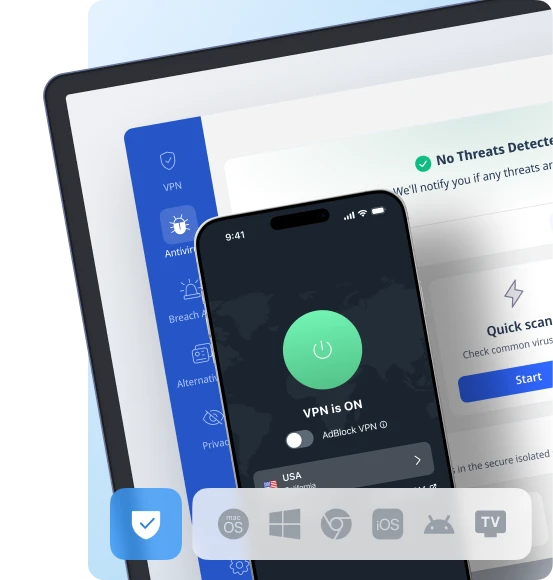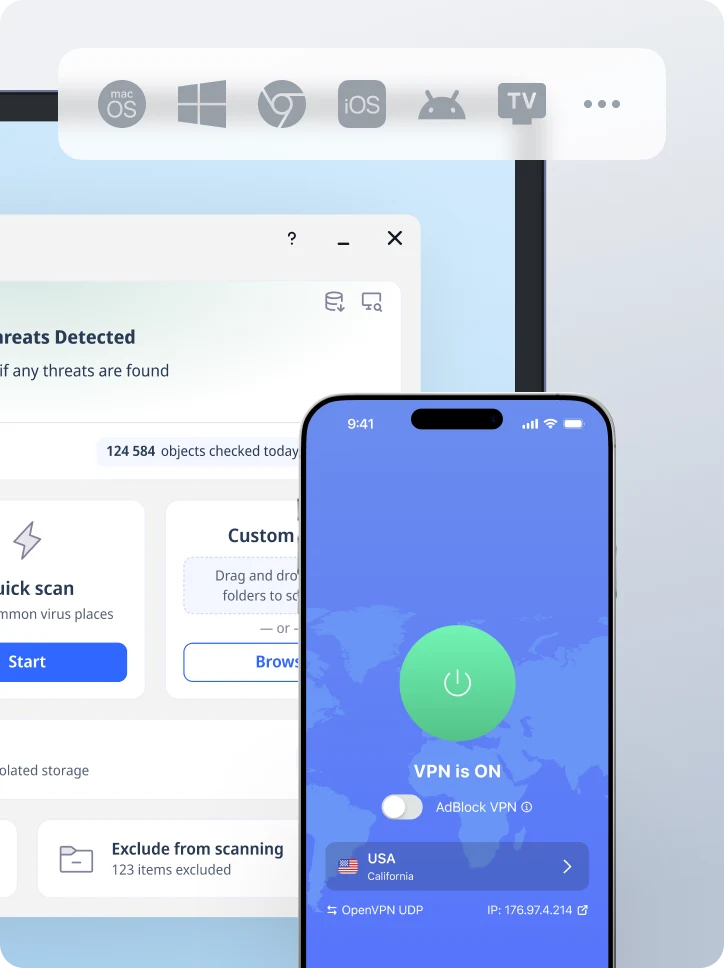What is an Open Proxy and Why the “Free Shortcut” Can Cost You Big Time
Most people find out about what is an open proxy after a quick “why is Instagram blocking me?” search or a friend’s tip for cheaper streaming. On paper the idea feels magical: you route your traffic through someone else’s computer, borrow a fresh IP, and walk right past geoblocks without paying a dime.
In reality, however, that same shortcut leaves your requests wide open to snoops, malware, and bandwidth‑hungry strangers you will never meet. Read on to find out the potential problems of using an open proxy and a safer alternative for better privacy.

Why VeePN beats an open proxy for real‑world privacy
Before we dig into the mechanics and the many myths about open proxies, here’s a smarter way to stay private without gambling on random public servers. If you use a reliable VPN like VeePN, you get:
Two‑layer encryption, not just IP masking
A classic proxy only hides the address. It never encrypts the packet. VeePN wraps every byte in AES‑256 encryption, then tunnels it through secure DNS to stop interceptions mid‑trip.
Clean, dedicated exit nodes
Open proxy servers are public web servers anyone can abuse, so their IP addresses get blacklisted fast. VeePN maintains 2 500+ hand‑picked servers in 89 countries, rotating hardware and wiping logs to keep your connection reputation intact.
Built‑in NetGuard threat blocker
Proxies pass every script and tracker straight to your browser. NetGuard strips ads, malicious domains, and trackers before they ever load, cutting risk and speeding page times.
Split tunneling for picky apps
You can route only streaming media through the tunnel while local banking traffic may stay direct. That means lower latency where you need it and bulletproof privacy where you don’t.
No‑Logs policy that’s audited, not promised
With VeePN there are no “server bandwidth statistics” stored on disk. Independent audits verify the claim, so cyber criminals or over‑curious website operators have nothing to subpoena.
Understanding the basics: what is an open proxy
An open proxy server is a publicly reachable proxy server that forwards anyone’s web requests to the wider internet. Because it doesn’t ask for log‑ins or network allow‑lists, any Internet user can point their browser at the IP and instantly appear to be connecting from that machine’s address.
In practice, your user’s device connects first to the proxy, the proxy relays traffic to a destination site, and the site responds back through the same channel. That simple chain lets you:
- hide users IP addresses from the final destination.
- Test firewalls by attempting an open proxy test on different ports.
- Slip past workplace content filtering or watch geographically restricted content that only plays in another region.
Thanks to free scripts like Squid and tiny digital‑ocean droplets, setting up a node takes minutes. That “typically free” nature fuels the myth that an open proxy is the fastest way to access content anonymously. Let’s see why the trade‑off rarely works out.
How an open proxy server routes your Internet traffic
So, the flow looks simple, but each hop exposes new risks:
Automatic redirect through open proxy ports
Your browser points at port 8080 (or 3128, 8000, 1080 for SOCKS). Any proxy software listening there grabs your request, rewrites packet headers, then pushes it onward. If misconfigured, the server may cache copies of everything you send, including login cookies.
Public web servers with zero vetting
Many “free lists” are compromised CCTV DVRs or shared hosting boxes. Attackers slip a relay script inside, open the port, and join it to a global network of thousands of various proxies. You inherit every past abuse record tied to that IP.
Return path reveals more than you think
While you surf Internet services or streaming media, the proxy can inject ads, steal session tokens, or block TLS upgrades. Without encryption, it can also log credentials in plain text.
Knowing that, the bargain starts to look thin, agree?
Advantages of free access via open proxies
However, open proxies can help in narrow scenarios, but only if you accept the downsides we will reveal in a bit:
- Bypass geo restrictions. Swapping to a Brazilian IP lets fans watch local football highlights otherwise hidden abroad. For a one‑off clip, a proxy might work.
- Boosting connection speeds (sometimes). A node close to a video CDN might shorten the route and shave milliseconds—until other users pile on and choke throughput.
- Quick troubleshooting for network pros. Security teams use open proxies to reproduce errors or view how a site loads from an overseas vantage.
Hidden costs of open proxies that kill the deal
- IP flagged by security tools. Cloudflare’s managed list of open proxy detection rules blocks millions of known hosts every day, so banking pages or checkout carts may simply refuse your session.
- Exposed user activity and credentials. No HTTPS interception needed: plain HTTP still pops up on older online programs, handing passwords to whoever controls the relay.
- DDoS abuse and legal headaches. Groups like Anonymous Sudan (aka LameDuck) funnel floods through third‑party open proxy resolvers, masking their real nodes and pushing attack traffic onto unaware owners’ VPS bills.
- Platform bans and service lockouts. Instagram famously blocks sign‑ups if an IP shows as open‑proxy, serving a “this address has been flagged” notice that can last days or weeks.
How website operators spot and stop an open proxy
Sites do not rely on guesswork, they have data and automation.
- Pen proxy detection feeds. Cloud‑scale firewalls subscribe to curated lists updated hourly. When your request matches, the rule blocks or challenges, often before the page even loads.
- Reverse DNS and latency clues. A home broadband IP rarely responds on port 8080, so a quick handshake plus high response times signals a proxy to the server.
- Reputation services and abuse reports. Databases like AbuseIPDB collect crowdsourced complaints. A single phishing campaign can put a fresh host on the “bad” list within minutes.
Private proxy, closed proxy, or VPN – choosing wisely
Not all relays are evil, but picking the right tool matters.
- Closed proxy (paid). Access keys limit users, cutting noisy neighbors. Still no encryption, but at least you avoid the random free access nature.
- Private proxy pools. Ideal for search‑engine scraping or ad verification. You pay for clean “virgin” IPs and keep them that way.
- Full VPN service. Combines IP reassignment, AES‑encrypted tunnels, custom DNS, and strict security measures. That’s why many users choose VPNs to increase Internet security protection.
However, steer clear of free VPNs, as they usually sell users’ data to third parties and may inject malware into your device.
Use VeePN for privacy‑first browsing
Here are other a few other reasons to use VeePN instead of open proxies:
- Obfuscated servers for stubborn regional blocks. Even networks that prohibit tunneling let VeePN slide by, thanks to stealth packet signatures.
- Kill Switch & DNS leak shield. If a tunnel drops, VeePN disconnects traffic instantly so you never fall back to a risky open proxy route.
- 10‑device allowance on one account. Protect a phone, laptop, smart TV, and test rig at once without extra fees.
- Smart location picker. Tap once to access geographically restricted content (think Hulu Japan or BBC iPlayer) with streaming‑optimized endpoints, not over‑crowded public proxies.
- WireGuard and OpenVPN protocols. Choose speed or compatibility on the fly and keep connection speeds steady even during 4K streams.
Try using VeePN without risks, as we offer a 30-day money-back guarantee.
FAQ
It means the address you’re using answers on common open proxy ports and forwards traffic for strangers. Security tools treat it as high‑risk, so log‑ins may fail and your IP flagged for abuse. Read more in this blog post.
Check your OS and router for unintended proxy services in network settings, close any rogue ports, or reboot to grab a clean dynamic IP. In stubborn cases, contact your ISP or switch to a reputable VPN to obtain a fresh address. Read more in this blog post.
Instagram blocks addresses that have routed spam or bot activity. If you share Wi‑Fi with someone running proxy software, you inherit their reputation. Changing networks or using a VPN with clean IP pools clears the error quickly. Read more in this blog post.
No. A VPN creates an encrypted tunnel and authenticates users, while an open proxy is publicly reachable and unencrypted. A solid VPN like VeePN offers the anonymity perks without exposing your data or letting strangers piggy‑back on your connection. Read more in this blog post.
VeePN is freedom
Download VeePN Client for All Platforms
Enjoy a smooth VPN experience anywhere, anytime. No matter the device you have — phone or laptop, tablet or router — VeePN’s next-gen data protection and ultra-fast speeds will cover all of them.
Download for PC Download for Mac IOS and Android App
IOS and Android App
Want secure browsing while reading this?
See the difference for yourself - Try VeePN PRO for 3-days for $1, no risk, no pressure.
Start My $1 TrialThen VeePN PRO 1-year plan







